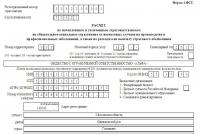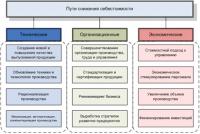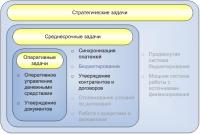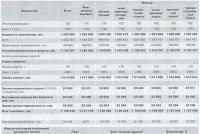Finances and their functions. Finance as an economic category. Financial system: links, spheres of financial relations Financial market, its structure and role
Finance is an economic social relationship, the subject of which
are the processes of accumulation, distribution and use of funds in the process of using the social product and income. On the one hand, this phenomenon is an economic category, and on the other hand, it is a subjective cost instrument of activity.
Finance is directly related to money. Money is a must
condition for the existence of finance. Finances act in monetary form, but not all monetary relations are financial. Monetary relations turn into financial ones when, as a result of the production of goods and the provision of services, funds of funds are created during their sale. Cash funds created at the level of the state, local governments are called centralized funds, and cash funds created at the level of economic entities, households are called decentralized.
Finance as a subjective cost instrument of functioning
economic entities form a specific decision-making mechanism regarding the processes of formation and use of monetary funds.
The object of finance is financial resources, which are
the totality of funds of funds at the disposal of economic entities, the state, households, i.e., this is money serving financial relations. They are formed in the process of material production, where new value is created and GDP and ND arise. Consequently, the amount of financial resources depends on the value of GDP and ND. Financial resources, their formation and use are reflected in the consolidated financial balance of the Russian Federation. The sources of financial resources are:
– at the level of business entities – profit, depreciation, sales proceeds
securities, bank credit, interest, dividends on securities issued by other issuers;
– at the population level – wages, bonuses, wage supplements, payments
social nature, carried out by the employer, travel expenses,
income from entrepreneurial activity, from participation in profits, from operations with personal property, from credit and financial operations; social transfers, including pensions, allowances, scholarships; consumer credit;
- at the level of the state, local governments - revenues from public
and municipal enterprises, income from the privatization of state and municipal property, income from foreign economic activity, tax income, state and municipal credit, issue of money and income from the issue of securities.
Thus, finance is a set of monetary relations that arise in the process of formation, distribution and use of centralized and decentralized funds of funds in order to fulfill the functions and tasks of the state and ensure conditions for expanded reproduction.
Financial system: links, spheres of financial relations.
The financial system is a combination of various spheres and links of financial relations interconnected. Links of the financial system.
1. The budget system is a combination of the federal budget, the budgets of the constituent entities of the Russian Federation, local budgets and budgets of extra-budgetary funds based on economic relations and the state structure of the Russian Federation.
Levels of the budget system:
1) the federal budget plus the budgets of state off-budget funds;
2) the budgets of the constituent entities of the Federation plus the budgets of state territorial off-budget funds;
3) local budgets. The budgets included in the budget system of the Russian Federation are independent and are not suddenly included in each other.
The structure of the budget system includes state non-budgetary funds. An off-budget fund is a fund of funds formed outside the federal budget and the budgets of the constituent entities of the Federation and intended to implement the constitutional rights of citizens to pensions, social insurance, health care and medical care.
Expenses and incomes of state off-budget funds are formed in the manner prescribed by federal law, or in the manner prescribed by the Budget Code.
2. State loan. Certain economic relations may develop between the state and legal entities and individuals, in which the state acts as a borrower, creditor, or guarantor. State credit combines the features of both finance and credit. As a link in the financial system, state credit serves the formation of centralized monetary funds. As a financial category, state credit performs distributive and control functions. Pursuing this or that financial policy, the state uses the state credit as a tool for regulating the economy. Acting in the financial market as a borrower, the state increases the demand for borrowed funds and thereby contributes to the growth of the price of credit, which reduces investment in production, but stimulates savings in the form of the purchase of government securities.
3. Decentralized finance:
1) finance of organizations is a system of monetary relations associated with the creation and use of various types of income and savings of an economic entity;
2) household finances are economic relations carried out by individual members of the household to create, distribute and use funds of funds in the course of their activities in order to meet their needs.
4. Insurance funds.
Insurance is a set of closed redistributive relations for the formation and use of trust funds to protect the property interests of individuals and legal entities and compensate them for material damage in connection with the consequences of insured events.
Insurance funds - the insurance market - a special form of organization of insurance relations, in which the purchase and sale of insurance services as a commodity takes place, the demand and supply for them are formed.
Test tasks in the discipline "Finance", the number of questions - 85 and the number of questions 65
Exercise 1
Question 1. Finance is:
1. economic category;
2. economic phenomenon;
3. subjective tool of the market economy;
4. cash.
Question 2. Finance as a phenomenon is:
1. cash;
2. unity of object and subject;
3. unity of at least two subjects, object and relations;
4. the unity of at least two subjects, object, relations and the state.
Question 3. How does the economic category of finance express:
1. relations of systematic formation and use of funds of monetary resources of economic entities;
2. relations regarding the formation and use of cash funds;
3. relations regarding the circulation of monetary resources;
4. relations regarding the functioning of loan capital.
Question 4. Finance as a subjective cost instrument is:
1. funds of economic entities;
2. plan of income and expenses of economic entities;
3. a conscious mechanism for the formation and use of monetary funds;
4. decision-making mechanism regarding the formation and use of monetary funds.
Question 5. The main meaning of finance is:
1. in ensuring the reproduction of material goods;
2. in the redistribution of funds between legal entities;
3. in the redistribution of funds from the possessing to non-producing physical entities;
4. in ensuring the turnover.
Task 2
Question 1. The financial system of a society is:
1. a set of spheres expressing the interrelationships of subjects regarding a change in a monetary object;
2. the totality of funds of all entities;
3. specific form of implementation of the state budget;
4. the totality of the country's budgets.
Question 2. Which sign of the classification of finance does not apply to the main ones?
1. subjective;
2. object;
3. formal;
4. social.
Question 3. What does not apply to the functions of the financial system?
1. distribution of monetary resources between the subjects of the company;
2. control of the movement and use of financial resources of the subjects of society;
3. redistribution of monetary resources between the subjects of the company;
4. prevention of losses of the company's subjects.
Question 4. The subject financial system does not include:
1. finances of citizens;
2. formal finance;
3. international finance;
4. finances of organizations.
Question 5. Name the most quantitatively significant area of finance:
1. public finance;
2. international finance;
3. finances of citizens;
4. finances of organizations.
Task 3
Question 1. What is "policy"?
1. special activities of people to protect the interests of society;
2. the concept of relations for the protection and realization of the interests of some subjects as opposed to the interests of other subjects of society;
3. special activities of state authorities;
4. special activities carried out in order to improve the welfare of the people.
Question 2. What is not the reason for the existence of politics?
1. variety of forms of ownership;
2. variety of needs of economic entities;
3. limited life values;
4. division of society into many economic entities.
Question 3. Arrange as you expand the following types of policies: financial (1), revenue (2), financial regulation policy (3), socio-economic (4).
1. 1, 2, 3, 4;
2. 3, 2, 1, 4;
3. 2, 3, 4, 1; 1
4. 4, 3, 1, 3.
Question 4. Which of the following policies does not apply to core areas?
1. individual;
2.state;
Additional Information
Question 5. Informal politics is:
1. policy implemented by citizens;
2. secret policy;
3. prohibited policy;
4. policy implemented by legal entities.
Task 4
Question 1. Financial management is:
1. the totality of all bodies and organizations that manage finances;
3. scientifically based management system of financial relations, cost flows and funds of the organization;
4. system of interaction of financial relations, flows and funds of funds.
Question 2. The objects of financial management are not:
1. cash funds;
2. cash flows;
3. categories and financial leverage;
4. budgetary relations.
Question 3. The reasons for financial management do not include:
1. the desire of the subject to lead;
2. the presence of an economic entity (organization);
3. action of commodity-money relations;
4. variety of forms of ownership.
Question 4. Strategic financial management is carried out by:
1. first persons (owner) of the organization;
3. control structures;
4. all members of the organization.
Question 5. The tactics of financial management are engaged in:
1. control structures;
2. second persons (performers);
3. first persons (owner) of the organization;
4. all members of the organization.
Task 5
Question 1. Financial forecasting is:
1. subjective activity of people to create forecasts;
2. a mechanism for predicting the state of the finances of a particular economic entity in the future, for one or another perspective;
3. scientifically substantiated system of management of financial relations, cost flows and funds of the organization;
4. the process of developing and adopting targets for the financial activities of economic entities.
Question 2. Forecasting methods do not include:
1. extrapolation;
2. modeling;
3. program-target;
4. method of expert assessments.
Question 3. Planning is:
1. the totality of all bodies and organizations that manage finances;
2. a set of objects and subjects of financial management;
3. scientifically based management system of financial relations, cost flows and funds of the organization;
4. subjective process of development and adoption of targets for the financial activities of economic entities.
Question 4. The objects of financial planning do not include:
1. cash funds;
2. cash flows;
3. economic categories;
4. budgetary relations.
Question 5. Does not engage in financial planning:
1. citizen;
2. designer;
3. Minister of Finance;
4. entrepreneur.
Task 6
Question 1. Give the correct definition of financial control:
1. one of the stages of financial management;
2. a set of measures of the subjective activity of people to observe, compare, verify and analyze the movement of monetary resources;
3. a set of actions to verify the activities of business entities;
4. form of implementation of the control function of finance.
Question 2. What does not apply to the main reasons for the need to control socio-economic processes?
1. lack of 100% probability in a certain development of processes;
2. the importance of preventing the emergence of crisis situations;
3. desire to develop the success of a particular activity;
4. detection of financial violations.
Question 3. Public financial violations do not include:
1. misuse of financial resources;
2. unprofitable activity of organizations;
3. secret borrowing of funds from some entities from others;
4. corruption.
Question 4. What does not apply to the main tasks of financial control?
1. verification of expenses of all parts of the financial system;
2. compliance with the rules of accounting and reporting;
3. prevention of theft and identification of reserves for the effective use of funds;
4. checking the rules
Today finance
As economic category
Finance as
centralized funds decentralized.
The object of finance is financial resources,
The term "finance" comes from the Latin finis - end, end, finish. In the ancient world and the Middle Ages, in monetary relations arising between the state and the population, the word "finis" meant the final settlement, the completion of a monetary payment. Persons who paid contributions in favor of various state bodies received a document in their hands - fine. From the name of this document came the Latin term "financia", which meant a cash payment. The long process of development of commodity-money relations has changed the content of the phenomenon of finance.
Today finance- this is an objective economic phenomenon, which is a system of formation, distribution, redistribution and use of monetary funds of the subjects of society. On the one hand, this phenomenon is an economic category, and on the other hand, it is a subjective cost instrument of activity.
As economic category finance expresses economic relations over the production, distribution and use of gross domestic product and national income. These relations are manifested in the creation and use of targeted funds of funds by various economic entities (the state, business entities, interstate organizations, individuals, etc.).
Finance as subjective value instrument the functioning of economic entities form a specific decision-making mechanism regarding the processes of formation and use of monetary funds.
Finances act in monetary form, but not all monetary relations are financial. Monetary relations turn into financial ones when, as a result of the production of goods and the provision of services, funds of funds are created during their sale.
Funds of funds created at the level of the state, local governments are called centralized funds and monetary funds created at the level of economic entities, households - decentralized.
The object of finance is financial resources, representing a set of funds of funds at the disposal of economic entities, the state, households. The sources of financial resources are:
- at the level of economic entities - profit, depreciation, income from the sale of securities, bank credit, interest, dividends on securities issued by other issuers;
- at the population level - wages, bonuses, wage supplements, social payments made by the employer, travel expenses, income from entrepreneurial activities, profit sharing, transactions with personal property, credit and financial transactions; social transfers, including pensions, allowances, scholarships; consumer credit;
- at the level of the state, local governments - income from state and municipal enterprises, income from the privatization of state and municipal property, income from foreign economic activity, tax income, state and municipal credit, issue of money and income from the issue of securities.
All rights reserved. Materials on this site may only be used with a link to this site.
Essence of finance. Finance is an economic category of commodity production. Monetary nature of financial relations. The place of finance in the system of commodity-money relations. The boundaries of finance in the sphere of commodity-money relations. Specific features of finance. Financial resources as material carriers of financial relations. Definition of finance.
The relationship of finance with other economic categories in the process of cost distribution. Financial and price methods of cost distribution; their common features and differences. Finance and wages, their interaction. General and special in the functioning of finance and credit in the distribution process.
Section 1.1.1 Essence of finance
The term "finance" comes from the Latin "finis" - the end, end, finish. In the ancient world and the Middle Ages, in monetary relations between the state (king, judges, etc.) and the population, the word finis meant the final settlement, the completion of a monetary payment. Persons who paid dues in favor of a judge, king or various state bodies received a document - “fine” in their hands. From the name of this document came the Latin term "financia", which meant a cash payment.
In the 16th century, the term “finance” arose in France, meaning cash, income, payment. This term was used to define the totality of public revenues and expenditures and gradually transformed into the modern concept of finance.
The long process of development of commodity-money relations has radically changed the content of the phenomenon of finance. If earlier in these relations the main role was played by the monarch, the state as owners and supreme rulers, then in the second half of the 20th century, citizens become the main owners of values and enterprises, and the state, represented by authorities, acts as an intermediary and consumer of redistributed values. Most domestic economists of the socialist period of the 20th century rightly saw the essence of finance in the distribution and redistribution of monetary funds, but irrationally associated them, firstly, with expanded reproduction, and secondly, with the state.
To understand the existing variety of definitions, it is necessary to clearly trace the history of the phenomenon of finance.
In conditions of limited life values, the continuation of the human race is impossible without such a social process as their redistribution from able-bodied to disabled. The more a person produces a surplus product, the more value can be redistributed.
Redistribution can be direct and indirect. The first is carried out within the framework of one form of ownership, when there are no economic concepts of "mine", "yours". The second occurs through the economic concepts of “mine”, “yours”, this is a socially affirmed transition of the values of one economic entity (owner) to another, i.e. public institution of property.
A kind of catalyst for distribution and redistribution relations is the development and establishment of the universal dominance of commodity-money relations, the transformation of all values (material, spiritual, social, sensory, etc.) into goods and the need for their value expression in various market co-measurements (money, securities, etc.). .d.).
As a result, we observe the following phenomena:
formation of independent economic entities and owners of values;
widespread distribution and redistribution of life values;
isolation and constant changes in the real and fictitious value of material goods.
Their interaction gives rise to an objective system of movement of life values from one subject to another, which is a prototype, the basis of finance.
How does this sphere function, what is this phenomenon? How is money generated and spent? The answers to these and many other questions related to monetary funds are the subject of the study of finance. The object is personified economic subjects: a person, a team, a state and other structures.
Money performs various functions and, above all, the role of a measure of the usefulness of goods, a universal means of exchange and payment. They are not a direct source of additional life values, but act as an objective, independent of the consciousness of people, a specific form, a cost shell for the formation and use of monetary resources by specific subjects of society. The organic interaction of this shell, monetary resources and specific subjects forms finance.
Thus, finance is an objective economic phenomenon, which is a system for the formation, distribution, redistribution and use of monetary funds of society's subjects. On the one hand, this phenomenon is an economic category, and on the other hand, it is a subjective cost instrument of activity.
As an economic category, finance expresses the relationship between economic entities regarding the formation and use of monetary funds. That is, finance is not only money, but the organic unity of three elements: at least two subjects, an object, and the relations themselves. In the absence of any of them, finance as a category and phenomenon does not exist. The basic model of finance is the diagram in fig. 1.1.
Rice. 1.1. Finance Essence Model
The subjects of financial relations in a modern market economy can be: 1) citizens (individuals), 2) family, 3) organizations (legal entities), 4) state, 5) interstate legal entities (transnational and international organizations), 6) associations of states , 7) informal organizations (collectives). All of them become official counterparties in the presence of legal powers provided for by the relevant legislation.
The first three (1-4) types form the internal system of financial entities of each country, the last three (5-7) form the international sphere. Of course, real relations are much broader and more diverse. Along with the legal subjects of finance, there can be and there are non-legal, so-called informal subjects (organizing committees, clubs, lodges, “troikas”, “sevens”, etc.). They make financial decisions on the formation and use of funds from positions of strength, traditions, customs, "gentlemen's" agreements. There are especially many such entities in the category of individuals. They form the informal (shadow) sphere of education and distribution of funds.
The finance object represents financial resources. They cover the entire set of real and fictitious values that have a value expression. This is, firstly, money (paper, electronic, etc.), which in themselves do not contain value, but are capable of embodying real material, material, spiritual and social values; secondly, a variety of securities (stocks, bonds, patents, insurance, etc.), reflecting the tangible and intangible values of individuals, legal and government structures; thirdly, the various obligations of economic entities. At the same time, the assessment (cost) of fictitious values may be greater, lesser, or equal to the real values (the material content of national wealth, GDP).
The totality of relationships between subjects regarding the change of the object constitutes a complex multifaceted hierarchical system (Fig. 1.2).
1st group. The financial relations of citizens cover the connections between individuals - individuals. This includes various monetary relations regarding the formation and use of monetary funds of individuals within the circle of relatives, acquaintances, who are actively or passively involved in the activities of a particular person. This area of finance mediates consumption, reproduction and development of a person, as well as the process of production of life values at the primary level, sometimes including acts of buying and selling labor and other characteristic financial moments of a market economy. 
Rice. 1.2. System of financial relations
The relations of an individual with a family, which make up the 2nd group, are organically connected with this sphere.
The 3rd group includes the relations of individuals with non-state production, financial and credit, commercial and other organizations regarding the formation and use of financial resources. This is the main sphere of relations through which, on the one hand, the formation of income in the form of wages, dividends, interest, borrowed resources, etc. occurs, and on the other hand, investment in initial funds (fixed capital, etc.) of non-governmental organizations . The last point is extremely important for understanding the role and place of personal finance. It is he who radically changes the socio-economic significance of personal finance, turning them into a basic functional element and the legal basis of a market economy. The initial economic base of market economy enterprises under conditions of private ownership can be exclusively individual financial capital, the personal wealth of citizens. There is no impersonal joint, collective property, there is only management of joint property. Any association is built on the participation (share or full) of individual owners. Hence, all partnerships and joint-stock companies are ultimately pieces of personal finance. Accordingly, in the liquidation of organizations, the individual interests of shareholders and shareholders are satisfied first and last.
The 4th group of relations reflects the flow of funds between citizens and state legal entities, in which the main place is occupied by the movement, on the one hand, of payments to the budget, and on the other hand, various targeted cash payments from state organizations (wages to budget employees, state pensions, social benefits, etc.).
The 5th group of relations arises when there are several owners (shareholders, shareholders) of the organization and expresses the relationship between them regarding the formation of initial funds (initial capital) and the distribution of final financial results. This is the initial and final sphere of finance of collective entrepreneurial activity.
The 6th group of relations is the monetary relations of citizens with economic entities (individuals, non-state legal entities, state structures) of foreign states, as well as with interstate organizations and associations of countries in terms of investments, income, payments, sponsorship, etc.
7th group - relations of non-governmental organizations with other non-governmental production, financial-credit, commercial and other organizations regarding the formation and use of financial resources. Through this sphere of relations, on the one hand, the formation of dividends, interest, borrowed resources, etc. occurs, and on the other hand, the sale of created goods and services. The last point is important for understanding the role and place of finance organizations. It is he who ensures the market recognition and monetary metamorphosis of the newly created value of goods and the subsequent satisfaction of the material interests of the participants in production - the owners in income, and employees - in wages.
The 8th group of relations reflects the relations between non-governmental organizations and state legal entities, in which the main place is occupied by the movement, on the one hand, of payments to the budget, and on the other, various purposeful cash payments from state organizations.
The 9th group of relations is the monetary relations of non-state organizations with economic entities (individuals, non-state legal entities, state structures) of foreign states, as well as interstate organizations and associations of countries in terms of the sale and purchase of labor, investments, income, payments, sponsorship etc.
The 10th group of relations covers the relations of the state with foreign economic entities.
The totality of these relations can be classified not only by subjects, but also by a) functional role and significance in a market economy (consumer of life values and producer-consumer); b) the size and nature of monetary funds; c) the degree of planned relations.
Initial, main and final are the relations of individuals. Their purpose is to ensure the realization of human needs, its development and reproduction through the formation and use of monetary funds. According to the degree of regularity, financial relations are planned, predictive (indicative) and chaotic. Much is determined by the interaction of forms of ownership.
According to the social form, relations are divided into formal and informal. Formal relations are those corresponding to generally recognized forms (law) of society. Informal relations are unspoken, non-legal relations (racketeering, theft, robbery, looting, etc.).
The object of relations is the value of GDP, total product, and sometimes national wealth. All this makes finance a powerful economic tool for the distribution and redistribution of the value of life values between the economic entities of a society with a market economy.
Finance as a subjective cost tool for the functioning of economic entities form a decision-making mechanism regarding the formation and use of monetary funds.
Specialty 050509 "Finance"
Questions to the section "Finance"
The concept of finance, their need
concept "finance" covers a wide area of economic relations related with distribution social product in the form of money.
The external manifestation of finance in economic life occurs in the form of the movement of funds among various participants in social production. On the surface of phenomena, this movement represents the transfer of sums of money from one owner to another in the form of non-cash or cash payments. This feature was manifested in the origin of the term "finance", from the Latin "finis" - end, finish, end of payment, settlement between the subjects of economic relations (originally in Ancient Rome - between the population and the state). Later, the term was transformed into "finansia", which was used in a broad sense as a cash payment, and then - as a set of income and expenses of the state and any economic units, their complexes.
Hence, obviously, finance includes the range of operations that takes place in the form of a cash payment.
As a rule, cash payments are made between various entities participating in social production. At the same time, money serves the entire process of activity of market entities both in the areas material production and commodity circulation, as well as in non-productive sphere activities.
The concept of "finance" is often identified with money. This is due to the fact that at the level of public perception - money and finance are difficult to distinguish, although in essence they are different economic phenomena.
The functioning of money as an economic instrument differs from finance, both in essence and in purpose. money feature lies in the fact that they represent a universal equivalent by which the labor costs of associated commodity producers are measured. The main purpose of money expressed in their functions: measures of value, means of circulation, means of payment, means of accumulation and savings, world money.
At the same time, the presence of money in the economic system is a prerequisite for the functioning of finance. In other words, finance cannot exist without money. However, this does not mean that money is the origin of finance.
Unlike money finance always an intangible thing.
Finance feature is that it is, first of all, a tool for the distribution and redistribution of the gross domestic product.
The main purpose of finance is to meet the various needs of the subjects of society by creating cash income and funds. This is evidenced by all financial transactions.
Cause generating the emergence of finance, is the need of the state and various subjects for resources to ensure their activities.
For example: Subjects of the non-productive sphere of activity , which includes the entire social sphere: education, health care, culture, art, as well as areas of government, defense, etc., cannot function if they do not have the necessary amount of money to meet their needs related to the implementation of public purposes.
It is impossible to satisfy this need for resources without finance either in the sphere of management, or in the social sphere, or in the sphere of state activity: administration and defense. This is due to the fact that only with the help of finances is the distribution of value among the subjects of the reproduction process, that is, only through the financial distribution of the value of the gross national product, each participant in social reproduction receives its share in the created value and the cash flow receives a target designation.
In a market economy, the range of operations of individuals mediated by the movement of funds is expanding. In particular, citizens, engaged in various types of entrepreneurial activities without forming a legal entity, having a private sector, a household, receive income that serves as a source of covering their various needs, including those of a socially significant nature. Citizens pay various types of taxes and fees to the state budget.
Hence, the considered range of operations is accompanied by the movement of funds from one owner to another, and is made in the form of cash payments. Therefore, these operations are to financial transactions, and the process of cash flow is called finance.
Based on the above, we can formulate a definition: Finance is a set of special economic relations that arise in the process of distribution and redistribution of the value of a social product, as a result of which monetary incomes, savings and funds are formed and used by participants in reproduction to meet their various needs.
Specific signs of finance
monetary nature;
distributive character;
always expresses the one-way movement of the monetary form of value;
mandatory formation and use of financial resources.
A) On the surface of social processes, finance manifests itself through the movement of funds. Financial transactions are necessarily accompanied, firstly, by the transfer of funds from one owner to another, and secondly, by establishing their target designation. Consequently, finance differs from other economic categories in that it is a derivative of the monetary form of value. . When performing financial transactions, their monetary shell is visible, behind which the movement of value is hidden. That is, the economic basis for the functioning of finance is the movement of value in its monetary form. This circumstance allowssingle out their monetary character as an important specific feature of finance as an economic category.
B) Financial transactions manifest themselves not only as a movement of the monetary form of value, but also contain its distribution in their basis. For example, the financial transaction “payments to the budget” is carried out by distributing the created value on the basis of isolating from it the part that is transferred to the budget in the form of various types of taxes. In fact, there is a monetary payment of the subject to the state.
Consequently, in the system of monetary relations, finances are limited only by the distribution process. Therefore, the next specific feature of finance as an economic category is their distributive nature.
C) The distribution processes carried out by finance cover not only the value of the gross domestic product, but also apply to the entire gross national product, as well as part of the national wealth.
A feature of financial transactions, and, therefore, of finance is the fact that the movement of funds occurs unilaterally, that is Finances always express the one-way movement of the monetary form of value, which also characterizes their specific feature.
D) Not only finance, but also wages, price, credit, etc. take part in the distribution of the value of a social product. All these economic categories have different bases for functioning, each of them has its own characteristics, its own social purpose. On the basis of financial relations, a part of the value is separated in the form of savings and specific forms of net income are singled out in the gross income. These processes of distribution of the value of the gross domestic product are accompanied by the formation of special types of resources. Their peculiarity lies in the fact that they are formed at the disposal of various entities or the state as a result of the targeted separation of funds and are intended for further use in the interests of meeting public needs. Consequently, when distributing the value of the gross domestic product with the help of finance, there is necessarily a movement of funds that take on special forms of resources - income, deductions, receipts, savings, which together can be called financial resources. Hence, the next specific feature of finance as an economic category is the mandatory formation and use of financial resources.
Functions of Finance
distribution function implements the public purpose of finance - providing each participant in social reproduction (both business entities and the state) with the necessary financial resources, as well as determining the directions of cash flows for the intended purpose.
control function. The implementation of the control function of finance is reflected in the state of financial discipline in the economy.
financial discipline- it is mandatory for all legal entities and individuals engaged in entrepreneurial activities, as well as officials, the procedure for conducting financial management, compliance with established norms and rules, fulfillment of financial obligations.
In this way, the ability to "signal" about the course of the distribution process, manifests itself through the control function of finance. The so-called “financial signals” show how the proportions are formed in the distribution of funds, how timely financial resources are at the disposal of the state and other participants in the reproduction process, whether they are used economically, etc. Basic requirement of financial discipline- exact observance of norms, standards, limits, control figures and other financial parameters defined by law or enshrined in regulatory legal acts of the state. In a broad sense, financial discipline includes fiscal discipline, payment discipline and settlement discipline. Financial discipline is an important means of promoting economic development, strengthening commercial calculation and a necessary condition for the normal functioning of finance. It is determined both by the general principles of the organization of finance, and by the specific conditions for the functioning of finance in various structural divisions of social reproduction.






